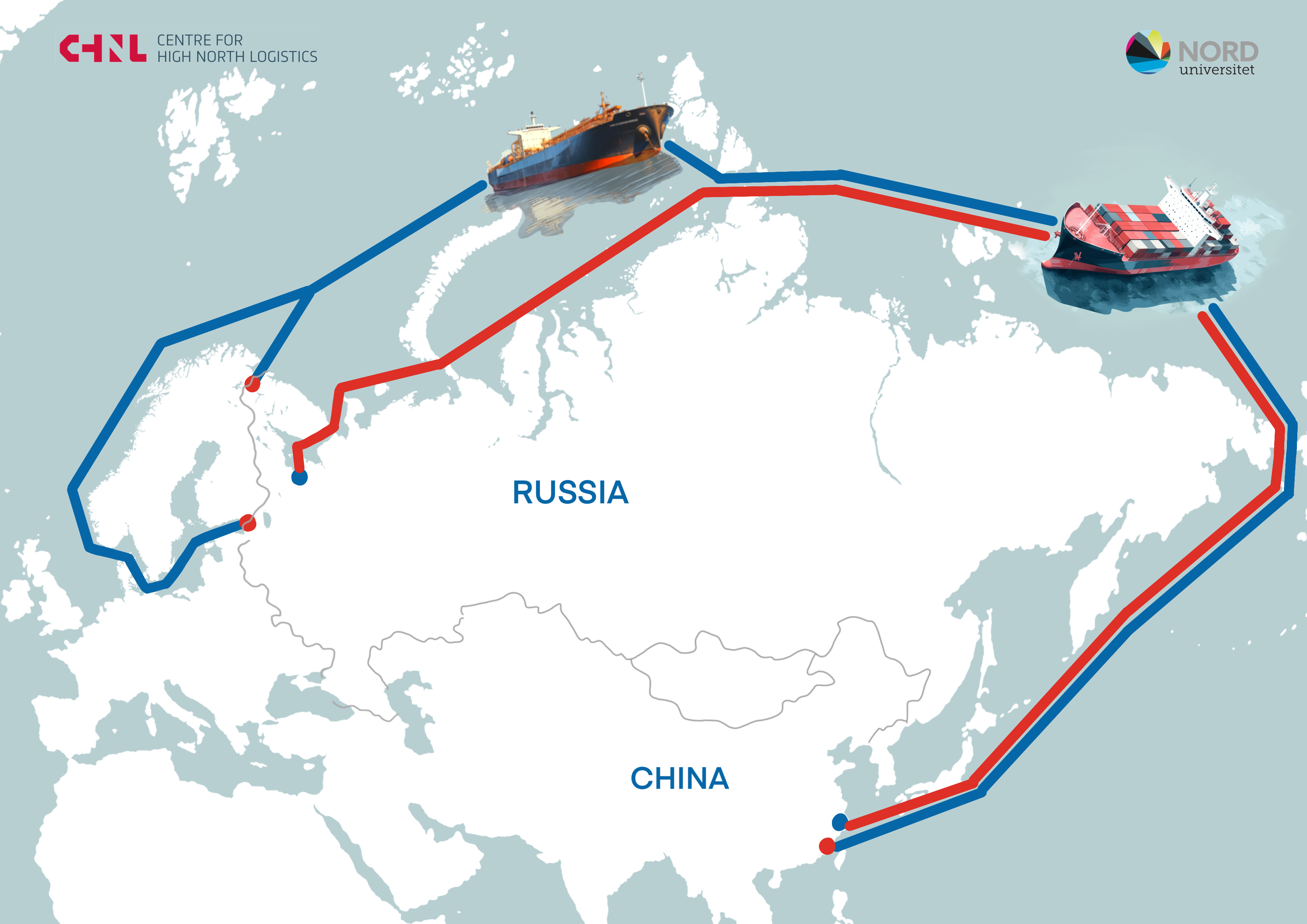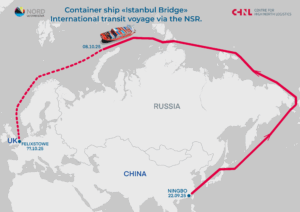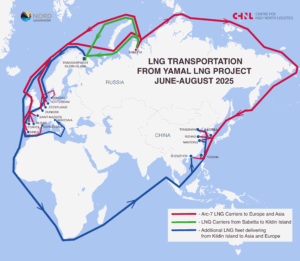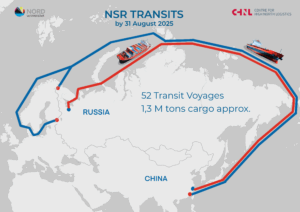CHNL publishes the next update of NSR transit voyages in 2024. Please note that all information below refers to NSR transit voyages and not to all traffic at NSR. Voyage and cargo data are obtained from various sources, including AIS data on vessel traffic, and represent our preliminary estimates.
Summer-autumn navigation is still in progress, but after October 15 all vessels without ice class are restricted from operating in the eastern sector of the NSR, and vessels with ice class Ice 1 – Ice 3 must leave the eastern areas of the NSR by October 20. Thus, due to early ice formation this year time for transit passages is reduced. In the remaining weeks we most probably will see several more transit passages.
Key facts
As of September 30, we recorded 79 transit voyages and an estimated 2.38 million tons of transit cargo. If our observations are correct, this is already a new record of transit cargo at the NSR. In order to say this with full confidence we need to wait for the end of the season and official results of the transit navigation. So far about 95% of the cargo volume goes from Russia to China. The share of crude oil in the cargo flow is about 62% or 1.47 million tons, another 27% or 646 000 tons are dry bulk cargoes. The share of containerized cargo is about 6% or 153 000 tons. There are no international transit voyages.
Table 1: Transit voyages and cargoes in the West / East segmentation (updated 30.09.24)

Destinations and types of transportation.
Out of 79 transit voyages, 28 proceed from Russia to China, another 26 from China to Russia, the remaining 25 voyages went between 2 Russian ports (10 eastbound and 15 westbound). This makes a total of 38 eastbound and 41 westbound voyages.
According to the type of transportation, we subdivided the shipments into cargo voyages and ballast voyages. Of the 79 transits, we estimate that 46 vessels carried cargo (31 eastbound and 15 westbound) and 33 vessels traveled in ballast (7 eastbound and 26 westbound). Further we will consider transportations by cargo types and make overview of ballast voyages.
1. Transit voyages with cargo from Russia to China.
1.1 Crude oil.
10 tankers with crude oil totaling 1.1 million tons left Murmansk port for China. Also, 3 voyages with 320,000 tons of crude oil departed from the port of Primorsk. One more voyage with 66,000 tons of oil was sent directly from the Prirazlomnaya oil platform. In total we recorded 14 voyages with 1.476 mln tons of crude oil.
Table 2: Cargo from Russia to China. Crude oil. (updated 30.09.24)

1.2 Bulk cargoes
Three voyages with coal in total volume of 245,000 tons departed from the port of Ust-Luga. From the port of St. Petersburg 2 voyages with mineral fertilizers with total volume of 86,000 tons. From Murmansk 2 voyages with 315 000 tons of iron ore concentrate. In all, 7 voyages with a total volume of 646,000 tons.
Table 3: Cargo from Russia to China. Bulk cargos. (updated 30.09.24)

1.3 LNG
One shipment of 72,000 tons of LNG was delivered from the Russian port of Vysotsk to China. It should be reminded that in this publication we consider only transit voyages via NSR. A separate article will be devoted to the analysis of LNG volumes from coming Sabetta port.
1.4 Containerized cargoes There were 6 vessels carrying containers from Russia to China via the NSR with a total cargo volume of about 72,000 tons.
Table 4: Cargo from Russia to China. Containerized cargos. (updated 30.09.24)

Four vessels left the port of Arkhangelsk, all of them earlier came to Arkhangelsk with cargo from China, i.e. these are return voyages. One more 5th vessel, which is now coming from China to Arkhangelsk, most likely will not have time to return back via the NSR.
Also 2 voyages left St. Petersburg port for China. One of them is Flying Fish 1 – the largest container ship that has ever entered the NSR. The length of the vessel is 294 meters, the estimated cargo is 41,000 tons. The second transit from St. Petersburg to China is a voyage of container ship Hui Da 9, possibly without cargo, but we do not have exact data on this voyage. Earlier this vessel came from China via NSR.
2. Transit voyages with cargo from China to Russia.
2.1 Containerized cargoes
Unlike crude oil and bulk cargoes, containerized cargoes between Russia and China are transported in both directions. There were 8 voyages from China via the NSR to Russia with a total cargo volume of about 74,800 tons.
Of these, 5 vessels carrying 30,000 tons of cargo headed to the port of Arkhangelsk, 4 of which have already left for return voyages to China, and the 5th vessel Hue Fa is still proceeding along the NSR with the expected date of arrival in Arkhangelsk on October 4.
Table 5: Cargo from China to Russia. Containerized cargos to Arkhangelsk (updated 30.09.24)

The other 3 voyages from China were directed to the port of St. Petersburg. 2 vessels have arrived and the third ship Newnew Panda 1 has just started her voyage and will soon enter the NSR water area. Expected date of arrival to St. Petersburg is October 20. Total cargo to St. Petersburg is about 44,800 tons.
Table 6: Cargo from China to Russia. Containerized cargos to St.Petersburg (updated 30.09.24)

The NSR transit has become part of the new multimodal line “Arctic Express No. 1” for the delivery of goods between China and Russia. Vessels are sent from Chinees ports to the port of Arkhangelsk, and then the goods are shipped by rail to the Bely Rast transportation and logistics complex in the Moscow region. Hongqi cars, spare parts sets for the production of Haval cars, clothing and footwear are transported from China to Russia. Cardboard, paper, pulp, lumber and polyethylene are shipped from Russia to China.
2.2 General cargo
The transit data for the NSR in 2024 includes 2 winter voyages (January-February) carrying modules for Arctic LNG-2 from China to Murmansk. These are Audax and Pugnax heavy load vessels. Another vessel Fesco Uliss carried general cargo from China to Ust Luga in August-September. A total of 26,000 tons of general cargo was transported.
Table 7: Cargo from China to Russia. General cargo (updated 30.09.24)

3. Transit voyages with cargo from Russia to Russia.
Transportation between Russian ports is a minor part of cargo traffic. Total 7 voyages with cargo of 13,600 tons. Voyages include 3 ships with container cargo – 7,900 tons, 2 ships with fish products – 1,700 tons, one tanker with oil products – 2,000 tons and one vessel with general cargo – 2,000 tons.
Table 8: Cargo from Russia to Russia (updated 30.09.24)

Next we examine transit voyages without cargo. Most of the ballast voyages – 26 out of 33 – are in the east-west direction and 7 in the west-east direction. For ease of understanding we have added the number of corresponding voyages in brackets to the headings.
4. Transit voyages without cargo (33 voyages).
4.1 Westbound (26 voyages)
China – Russia (15 voyages)
There were 15 ballast voyages from China to Russia including 8 tankers involved in crude oil transportation from Russia.
Table 9: Ballast voyages. Tankers from China to Russia. (updated 30.09.24)

Also 5 bulk carriers passed through NSR in ballast, but at the time of publication it is still unclear whether some of them will return eastward with cargo via the NSR. There is also a transit ballast passage from China to Russia of the LNG carrier North Sky, which earlier delivered LNG from Sabetta to China. Among other things, we have included in this list the Chinese icebreaker Hue Long 2, which passed from China to Murmansk, but did not formally enter the waters of the NSR. Her route westward passed north of the NSR waters, approximately in the area of 83-85 degrees of northern latitude.
Table 10: Ballast voyages. Bulkers, LNG and Icebreaker from China to Russia. (updated 30.09.24)

Russia – Russia (11 voyages)
There were 11 voyages in westbound direction between Russian ports along the NSR. Among them there were 2 large tankers, 1 bulk carrier and 2 LNG carriers.
Table 11: Ballast voyages westward between Russian ports. (updated 30.09.24)

4.2 Eastbound (7 voyages)
There were 7 transit voyages in ballast between 2 Russian ports in the eastern direction. Among them tanker Shturman Skuratov, which made the earliest transit voyage to the NSR in the summer navigation season of 2024. The return voyage of the Chinese icebreaker Hue Long 2 from Murmansk to P. Kamchatsky is also included here.
Table 12: Ballast voyages eastward between Russian ports. (updated 30.09.24)

Conclusions
Main NSR transit cargo goes from Russia to China. The biggest volume of cargo is crude oil. In fact, the NSR transit acts as an additional route for exporting resources from Russia to China during the summer-autumn period. We see that the number of container shipments has increased, while the favorable period of time for transit passage in 2024 is much shorter than usual due to difficult ice conditions in the eastern part of NSR.
Transit navigation in 2024 will soon come to an end, but there may be few more transit shipments. Among potential vessels there are 1 bulk carrier and 3 tankers in the port of Murmansk. The vessels are in or near the port and it is not clear what route they will take after loading. Also possible one voyage of bulk carrier from Baltic sea. And one more voyage of a container ship from China along the NSR can be expected. All these are still assumptions, which will be clarified in the next 1-2 weeks.
We would like to remind you that all the data provided are interim and up-to-date as of September 30, 2024. Our statistics include all vessels that have already started their voyages and intend to make a transit voyage along the NSR. We allow for the possibility of any changes in vessels’ intentions. Sometimes the declared port of destination may change during the voyage. Data on cargoes are estimated, i.e. presumptive, so we cannot guarantee complete accuracy. In this review we have only considered transit voyages through the entire NSR water area. In addition to that, there were also oil and LNG export voyages via NSR to the eastern direction. We will make a separate publication about it.







